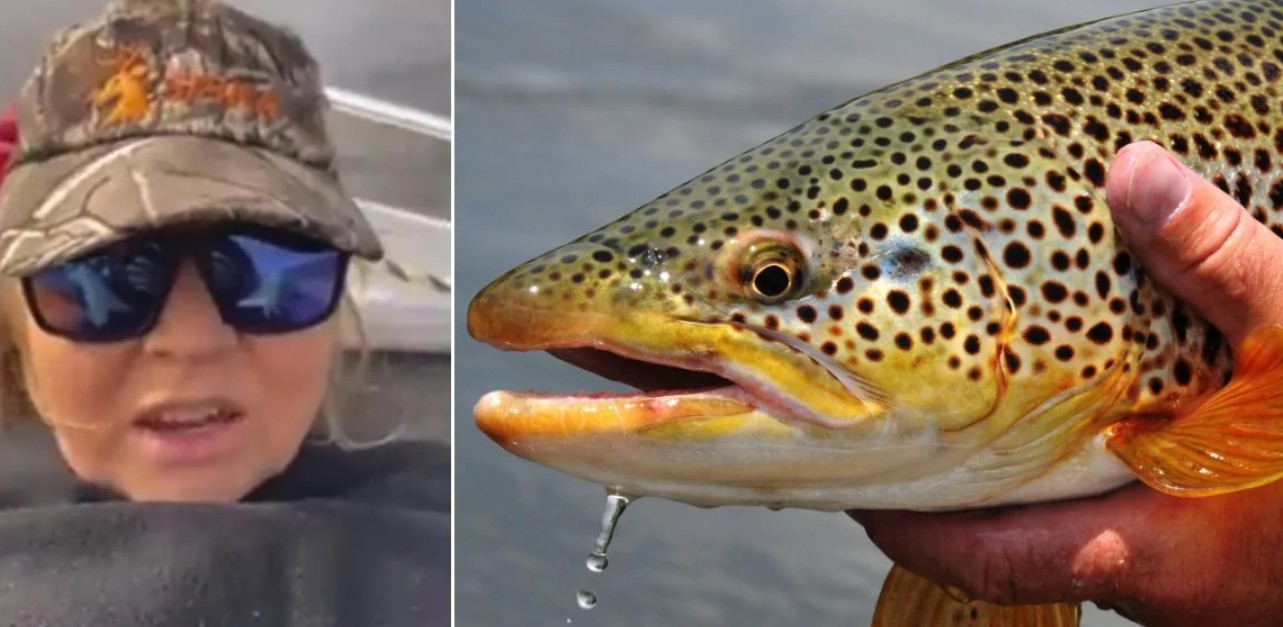Trout Lady Full Video and Controversy on Reddit, X-Twitter
In a case that has drawn widespread attention, Catherine June Lee, a 58-year-old woman from southern Tasmania, has made headlines following her recent court appearance. The legal proceedings arise from a highly controversial incident that circulated widely online through the “trout lady full video.” The footage allegedly depicts an act involving a live brown trout on a boat, which has sparked significant public outrage and legal scrutiny. Lee appeared at the Hobart Magistrates Court on Monday, August 19, 2024, marking her first appearance since the video gained international notoriety.

The video’s content not only provoked public condemnation but also resulted in serious legal consequences for those involved. Catherine June Lee faces multiple charges under the Classification (Publications, Films and Computer Games) Enforcement Act, including one count of possessing a bestiality product between February 2022 and January 2023, and two counts of making or reproducing a bestiality product during the same period. This court session represents an initial step in a case that involves deeply disturbing allegations and highlights the complex intersection of digital media circulation and criminal activity.
The incident and subsequent legal proceedings have ignited a broader conversation about the boundaries of acceptable conduct and the responsibilities of individuals in maintaining ethical standards in sharing digital content. As the case progresses, it continues to attract both legal scrutiny and public
Contents
Background of the Incident and Video
The case involving Catherine June Lee revolves around a disturbing video that emerged online, showing an act involving a live brown trout on a boat. The footage quickly gained attention across social media platforms, transforming what began as a local scandal into an international controversy. In the video, a woman identified as Lee is seen on a boat while a man allegedly engages with the trout in a manner considered bestiality. The graphic nature of the content immediately provoked widespread outrage and concern, drawing attention far beyond Tasmania.
Full Version Available for Public Viewing
trout-lady-full-video-no-blur.mp4
The video’s virality can be attributed both to its shocking content and the speed at which it spread across digital platforms. As views and shares multiplied, public reactions became increasingly vocal, with many expressing disgust and demanding legal action against those involved. The widespread circulation of the footage not only amplified the scandal but also underscored the powerful role of social media in accelerating the reach and impact of deeply disturbing material. This incident serves as a stark reminder of how quickly digital media can disseminate content with serious legal and ethical consequences.
Charges and Legal Proceedings
In the wake of widespread public outrage and the viral spread of the video, legal action was swiftly initiated against Catherine June Lee. She faces three formal charges under the Classification (Publications, Films and Computer Games) Enforcement Act, which governs the possession and distribution of explicit materials. Specifically, Lee is charged with one count of possessing a bestiality product, relating to her access to the controversial video between February 2022 and January 2023, and two counts of making or reproducing a bestiality product during the same period, reflecting her alleged role in creating and distributing the illicit content.

The severity of these charges underscores the serious nature of the offenses and the legal boundaries against such acts. During her appearance at the Hobart Magistrates Court, Magistrate Marica Duvnjak granted an adjournment, allowing additional time for investigation and preparation for what is expected to be a closely watched trial. The next court date is scheduled for October 2024, providing both the defense and prosecution the opportunity to gather evidence and build their cases. The adjournment also allows the legal system to address the complexities of the case in a measured manner, tempering immediate public reaction.
As the case unfolds, it continues to spark discussions about acceptable behavior and the impact of digital content on real-world outcomes. The charges against Lee not only address the specific actions depicted in the video but also highlight the broader responsibility individuals bear for the content they create and share. The outcome may set a precedent for handling future cases involving the intersection of digital media distribution and criminal activity.
Co-Accused Details
Alongside Lee, Ashley David Hallam, 55, also from Tasmania, is named as a co-accused in the highly publicized case. Authorities allege Hallam played a central role in the incident, and his legal proceedings reflect the gravity of the accusations.
Hallam made his first court appearance in May 2024, during which the charges against him were formally read. He faces two counts of making or reproducing a bestiality product and three counts of possessing a bestiality product. Compared to Lee, Hallam’s charges indicate potentially broader involvement in both the creation and possession of the illicit material.
The differences in charges suggest variations in the scope of each individual’s role in the events captured in the video. As the proceedings continue, the specifics of their involvement are expected to become clearer, which could influence the severity of any penalties if they are convicted.
Public and Legal Reaction
The release and viral spread of the video depicting an act with a live trout on a boat provoked immediate and intense public backlash. The footage, widely regarded as deeply disturbing, quickly reached a global audience, sparking outrage and demands for strict legal action. Social media platforms, public forums, and community discussions were flooded with expressions of shock and disgust at the explicit and unethical nature of the acts shown.
This strong public reaction prompted rapid police investigations. Law enforcement agencies moved quickly to identify and charge those involved, underscoring the seriousness with which the case was treated. The swift response also highlighted growing concerns over digital media’s capacity to disseminate illegal and harmful content, demonstrating the far-reaching influence of viral material.
Authorities issued statements reminding the public of the legal boundaries surrounding explicit content. They emphasized that possession or distribution of the video constitutes a criminal offense, stressing the responsibility individuals hold when handling and sharing digital material. These warnings served both as a deterrent and an educational message about the legal consequences of engaging with illicit content.
The legal and public reactions to this case underscore the broader societal implications of digital media, highlighting the shared responsibility of individuals to maintain ethical standards in their online interactions. As the case continues, it fuels ongoing debates about moral and legal boundaries, potentially shaping future legal frameworks and public attitudes toward digital content.
Legal Framework
The charges against Catherine June Lee and Ashley David Hallam are based on the Classification (Publications, Films and Computer Games) Enforcement Act, a key piece of Australian legislation regulating the classification and distribution of media content. The act is designed to protect the community from materials deemed offensive or harmful, particularly regarding explicit content, violence, and acts considered morally unacceptable, such as bestiality.
Under this law, the production, possession, or distribution of content involving bestiality is strictly prohibited and classified as a criminal offense. The legislation ensures that all publications, films, and computer games meet standards of public decency and morality. Enforcement involves evaluating the content’s impact on average viewers and determining its appropriateness for public access.
In the cases of Lee and Hallam, the charges specifically target their alleged roles in producing and possessing a bestiality product. The severity of the charges reflects the act’s strict stance against content that could corrupt public morals or encourage harmful behavior. These proceedings demonstrate the legal mechanisms in place to enforce standards and the consequences of violating such regulations.
The incident has drawn attention not only because of the disturbing nature of the alleged offenses but also due to the wider implications of viral digital content. The court proceedings address both individual accountability and societal boundaries regarding acceptable material. Lee’s court appearance in August 2024, followed by an adjournment to October, illustrates the legal system’s careful approach to complex cases involving digital media and controversial content.
This case highlights the ongoing challenges and responsibilities in the digital age. The ease of content creation and rapid online distribution often conflicts with legal standards and societal norms, requiring balanced governance and enforcement. The public’s strong reaction, coupled with legal action, reflects a collective commitment to protecting moral standards and public welfare.
As the case develops, it continues to generate active public discourse on digital ethics, privacy, and the limits of acceptable behavior. It serves as a reminder of how legal and social norms evolve alongside technology and media, and the outcome may shape future interpretations of law and public perception regarding similar issues.
Breaking News -Sean Herman Video Reveals Concerns Over Police Conduct
Katie Price Dubai Photo and Highlights Risks
Pan Piano Video Leak Causes Stir in Online Communities
Christine Chubbuck Video Sparks Debate on Journalism Ethics
Prison Officer Wandsworth Video Leak in Prison Chaos
Georgie Cooper Video Leak and Community Reactions
Yes King Original Video and Its Rise Across Social Platforms
